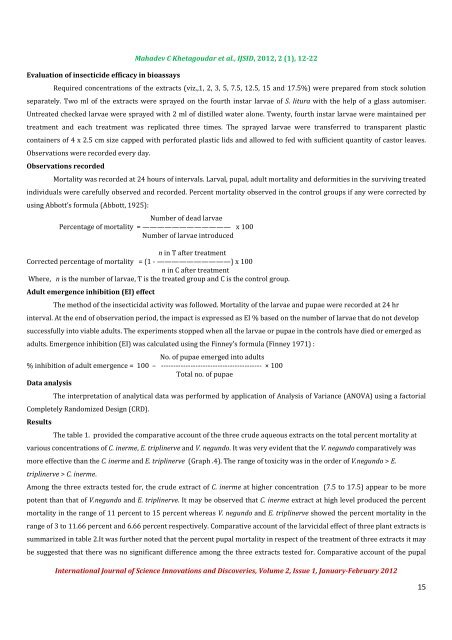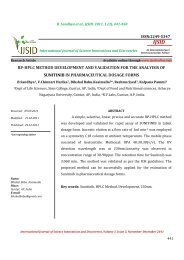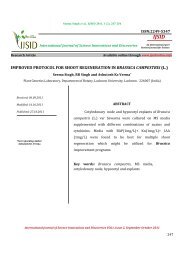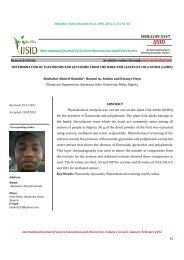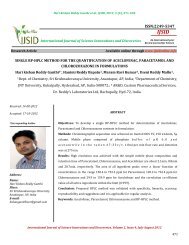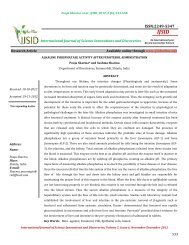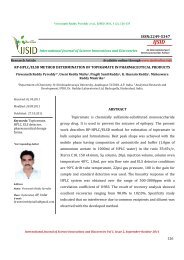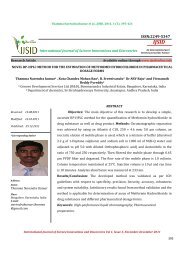(fab.) (lepidoptera: noctuidae) larvae - Ijsidonline.info
(fab.) (lepidoptera: noctuidae) larvae - Ijsidonline.info
(fab.) (lepidoptera: noctuidae) larvae - Ijsidonline.info
Create successful ePaper yourself
Turn your PDF publications into a flip-book with our unique Google optimized e-Paper software.
Evaluation of insecticide efficacy in bioassaysMahadev C Khetagoudar et al., IJSID, 2012, 2 (1), 12-22Required concentrations of the extracts (viz.,1, 2, 3, 5, 7.5, 12.5, 15 and 17.5%) were prepared from stock solutionseparately. Two ml of the extracts were sprayed on the fourth instar <strong>larvae</strong> of S. litura with the help of a glass automiser.Untreated checked <strong>larvae</strong> were sprayed with 2 ml of distilled water alone. Twenty, fourth instar <strong>larvae</strong> were maintained pertreatment and each treatment was replicated three times. The sprayed <strong>larvae</strong> were transferred to transparent plasticcontainers of 4 x 2.5 cm size capped with perforated plastic lids and allowed to fed with sufficient quantity of castor leaves.Observations were recorded every day.Observations recordedMortality was recorded at 24 hours of intervals. Larval, pupal, adult mortality and deformities in the surviving treatedindividuals were carefully observed and recorded. Percent mortality observed in the control groups if any were corrected byusing Abbott’s formula (Abbott, 1925):Number of dead <strong>larvae</strong>Percentage of mortality = ———————————— x 100Number of <strong>larvae</strong> introducedn in T after treatmentCorrected percentage of mortality = {1 - ——————————} x 100n in C after treatmentWhere, n is the number of <strong>larvae</strong>, T is the treated group and C is the control group.Adult emergence inhibition (EI) effectThe method of the insecticidal activity was followed. Mortality of the <strong>larvae</strong> and pupae were recorded at 24 hrinterval. At the end of observation period, the impact is expressed as EI % based on the number of <strong>larvae</strong> that do not developsuccessfully into viable adults. The experiments stopped when all the <strong>larvae</strong> or pupae in the controls have died or emerged asadults. Emergence inhibition (EI) was calculated using the Finney’s formula (Finney 1971) :No. of pupae emerged into adults% inhibition of adult emergence = 100 – ----------------------------------------- × 100Total no. of pupaeData analysisThe interpretation of analytical data was performed by application of Analysis of Variance (ANOVA) using a factorialCompletely Randomized Design (CRD).ResultsThe table 1. provided the comparative account of the three crude aqueous extracts on the total percent mortality atvarious concentrations of C. inerme, E. triplinerve and V. negundo. It was very evident that the V. negundo comparatively wasmore effective than the C. inerme and E. triplinerve (Graph .4). The range of toxicity was in the order of V.negundo > E.triplinerve > C. inerme.Among the three extracts tested for, the crude extract of C. inerme at higher concentration (7.5 to 17.5) appear to be morepotent than that of V.negundo and E. triplinerve. It may be observed that C. inerme extract at high level produced the percentmortality in the range of 11 percent to 15 percent whereas V. negundo and E. triplinerve showed the percent mortality in therange of 3 to 11.66 percent and 6.66 percent respectively. Comparative account of the larvicidal effect of three plant extracts issummarized in table 2.It was further noted that the percent pupal mortality in respect of the treatment of three extracts it maybe suggested that there was no significant difference among the three extracts tested for. Comparative account of the pupalInternational Journal of Science Innovations and Discoveries, Volume 2, Issue 1, January-February 201215


